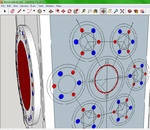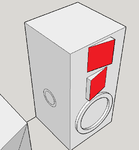Audioguru
Advanced Member level 7

- Joined
- Jan 19, 2008
- Messages
- 9,461
- Helped
- 2,152
- Reputation
- 4,304
- Reaction score
- 2,011
- Trophy points
- 1,393
- Location
- Toronto area of Canada
- Activity points
- 59,764
I have my stereo playing and have my Sound Level Indicator project flashing its LEDs to the sounds of music. It has a microphone and picks up all sound frequencies. Set for DOT mode then only one LED is on at a time. If I look at only one LED near the top (fairly loud sounds) then it lights briefly only during low frequency drum beats. When turned up louder then this LED also lights with low frequency bass sounds.
The circuit has an opamp peak detector/rectifier with a very fast rise-time and a fairly slow fall-time of 100ms. The fall time is slow enough (>30ms) so that short duration sounds are seen at full brightness but is fast enough for all multiple fast beats to be seen. The peak detector circuit feeds the comparators in the LM3915 LED driver IC.
Right now Justin Bieber (a Canadian like me) is singing his song "Sorry" and the top LED is showing the bass beat: boom, ba-boom, boom, ba-boom, boom, ba-boom, boom, ba-boom. So I think the rise-time and fall-time should be in the peak detector/rectifier that feeds the comparator. The comparator or another opamp can buffer the high resistance for the fall-time and can drive a Mosfet or power transistor that lights the LEDs. I think an opamp is better than a comparator since it has plenty of going high output current for a fast rise-time.
The circuit has an opamp peak detector/rectifier with a very fast rise-time and a fairly slow fall-time of 100ms. The fall time is slow enough (>30ms) so that short duration sounds are seen at full brightness but is fast enough for all multiple fast beats to be seen. The peak detector circuit feeds the comparators in the LM3915 LED driver IC.
Right now Justin Bieber (a Canadian like me) is singing his song "Sorry" and the top LED is showing the bass beat: boom, ba-boom, boom, ba-boom, boom, ba-boom, boom, ba-boom. So I think the rise-time and fall-time should be in the peak detector/rectifier that feeds the comparator. The comparator or another opamp can buffer the high resistance for the fall-time and can drive a Mosfet or power transistor that lights the LEDs. I think an opamp is better than a comparator since it has plenty of going high output current for a fast rise-time.






